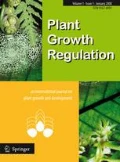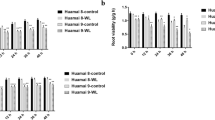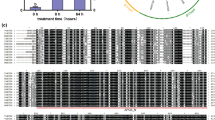Abstract
Aluminum is one of the toxic elements in acid soil which can restrain plant growth. Autophagy, a dynamic process that involves the recycling of the degradation of intracellular materials, can be induced by multiple abiotic stresses in Arabidopsis. However, the relationship between aluminum and autophagy in plant is unclear while it has been reported that aluminum can increase astrocyte autophagy levels in animals. The role of autophagy in aluminum stress response in Arabidopsis was therefore studied. Our results showed that aluminum can increase expression of autophagy-related genes’ level, moreover, autophagy defective mutants were more sensitive to aluminum conditions and showed more serious damages than wild-type plants, including higher oxidative damages and more reactive oxygen species (ROS) accumulation. Then, inductions of defense-associated genes in autophagy defective mutants were less than that observed in the wild-type plants after aluminum treatment, whereas the former had higher antioxidant enzymes activity. Furthermore, mutants were more compromised in PSII photochemistry and their detached leaves had less ability to stay green under aluminum treatment. These results indicate that aluminum can induce autophagy and the latter is necessary for defense responses to aluminum toxicity in Arabidopsis thaliana, and it may relieve this damage by eliminating the overproduction of ROS.






Similar content being viewed by others
References
Altschuler E (1999) Aluminum-containing antacids as a cause of idiopathic Parkinson’s disease. Med Hypotheses 53(1):22–23
Apel K, Hirt H (2004) Reactive oxygen species: metabolism, oxidative stress, and signal transduction. Annu Rev Plant Biol 55:373–399
Bassham DC (2007) Plant autophagy—more than a starvation response. Curr Opin Plant Biol 10(6):587–593
Bassham DC, Laporte M, Marty F, Moriyasu Y, Ohsumi Y, Olsen LJ, Yoshimoto K (2006) Autophagy in development and stress responses of plants. Autophagy 2(1):2–11
Boscolo PR, Menossi M, Jorge RA (2003) Aluminum-induced oxidative stress in maize. Phytochemistry 62(2):181–189
Cheng J, He CX, Zhang ZW, Xu F, Zhang DW, Wang X, Yuan S, Lin HH (2011) Plastid signals confer Arabidopsis tolerance to water stress. J Biosci 66(11):47
Cheng J, Yuan S, Zhang ZW, Zhu F, Tang H, Xu F, Feng H, Xie HF, Xu WL, Lin HH (2012) Plastid-signalling-mediated anthocyanin accumulation in mature Arabidopsis rosettes. Plant Growth Regul 68(2):223–230
Cummins I, Wortley DJ, Sabbadin F, He Z, Coxon CR, Straker HE, Sellars JD, Knight K, Edwards L, Hughes D (2013) Key role for a glutathione transferase in multiple-herbicide resistance in grass weeds. Proc Natl Acad Sci 110(15):5812–5817
Delhaize E, Ryan PR (1995) Aluminum toxicity and tolerance in plants. Plant Physiol 107(2):315
Doelling JH, Walker JM, Friedman EM, Thompson AR, Vierstra RD (2002) The APG8/12-activating enzyme APG7 is required for proper nutrient recycling and senescence in Arabidopsis thaliana. J Biol Chem 277(36):33105–33114
Durrant W, Dong X (2004) Systemic acquired resistance. Annu Rev Phytopathol 42:185–209
Ezaki B, Suzuki M, Motoda H, Kawamura M, Nakashima S, Matsumoto H (2004) Mechanism of gene expression of Arabidopsis glutathione S-transferase, AtGST1, and AtGST11 in response to aluminum stress. Plant Physiol 134(4):1672–1682
Foyer CH, Bloom AJ, Queval G, Noctor G (2009) Photorespiratory metabolism: genes, mutants, energetics, and redox signaling. Annu Rev Plant Biol 60:455–484
Frisardi V, Solfrizzi V, Capurso C, Kehoe PG, Imbimbo BP, Santamato A, Dellegrazie F, Seripa D, Pilotto A, Capurso A (2010) Aluminum in the diet and Alzheimer’s disease: from current epidemiology to possible disease-modifying treatment. J Alzheimers Dis 20(1):17–30
Fu FQ, Zhang DW, Deng XG, Li JY, Peng XJ, Tang H, Lin HH (2014) Role of plastid signals in modulating Arabidopsis responses to Cucumber mosaic virus. Plant Growth Regul 75(3):761–769
Hanaoka H, Noda T, Shirano Y, Kato T, Hayashi H, Shibata D, Tabata S, Ohsumi Y (2002) Leaf senescence and starvation-induced chlorosis are accelerated by the disruption of an Arabidopsis autophagy gene. Plant Physiol 129(3):1181–1193
Jian W, Zhang DW, Zhu F, Wang SX, Zhu T, Pu XJ, Zheng T, Feng H, Lin HH (2015) Nitrate reductase-dependent nitric oxide production is required for regulation alternative oxidase pathway involved in the resistance to Cucumber mosaic virus infection in Arabidopsis. Plant Growth Regul 77(1):99–107
Jiang HX, Chen LS, Zheng JG, Han S, Tang N, Smith BR (2008) Aluminum-induced effects on Photosystem II photochemistry in Citrus leaves assessed by the chlorophyll a fluorescence transient. Tree Physiol 28(12):1863–1871
Jones DL, Kochian LV (1995) Aluminum inhibition of the inositol 1,4,5-trisphosphate signal transduction pathway in wheat roots: a role in aluminum toxicity? Plant Cell 7(11):1913–1922
Kametaka S, Okano T, Ohsumi M, Ohsumi Y (1998) Apg14p and Apg6/Vps30p form a protein complex essential for autophagy in the yeast, Saccharomyces cerevisiae. J Biol Chem 273(35):22284–22291
Kobayashi Y, Hoekenga OA, Itoh H, Nakashima M, Saito S, Shaff JE, Maron LG, Pineros MA, Kochian LV, Koyama H (2007) Characterization of AtALMT1 expression in aluminum-inducible malate release and its role for rhizotoxic stress tolerance in Arabidopsis. Plant Physiol 145(3):843–852
Kochian LV (1995) Cellular mechanisms of aluminum toxicity and resistance in plants. Annu Rev Plant Biol 46(1):237–260
Kochian LV, Hoekenga OA, Pineros MA (2004) How do crop plants tolerate acid soils? Mechanisms of aluminum tolerance and phosphorous efficiency. Annu Rev Plant Biol 55:459–493
Kwak JM, Nguyen V, Schroeder JI (2006) The role of reactive oxygen species in hormonal responses. Plant Physiol 141(2):323–329
Lei T, Feng H, Sun X, Dai QL, Zhang F, Liang HG, Lin HH (2010) The alternative pathway in cucumber seedlings under low temperature stress was enhanced by salicylic acid. Plant Growth Regul 60(1):35–42
Levine B, Klionsky DJ (2004) Development by self-digestion: molecular mechanisms and biological functions of autophagy. Dev Cell 6(4):463–477
Li JY, Deng XG, Chen LJ, Fu FQ, Pu XJ, Xi DH, Lin HH (2015) Involvement of PHYB in resistance to Cucumber mosaic virus in Nicotiana tabacum. Plant Growth Regul 77(1):33–42
Lim PO, Kim HJ, Gil Nam H (2007) Leaf senescence. Annu Rev Plant Biol 58:115–136
Liu Y, Schiff M, Czymmek K, Tallóczy Z, Levine B, Dinesh-Kumar S (2005) Autophagy regulates programmed cell death during the plant innate immune response. Cell 121(4):567–577
Liu J, Magalhaes JV, Shaff J, Kochian LV (2009) Aluminum-activated citrate and malate transporters from the MATE and ALMT families function independently to confer Arabidopsis aluminum tolerance. Plant J 57(3):389–399
Liu J, Li Z, Wang Y, Xing D (2014a) Overexpression of ALTERNATIVE OXIDASE1a alleviates mitochondria-dependent programmed cell death induced by aluminium phytotoxicity in Arabidopsis. J Exp Bot 65(15):4465–4478
Liu Y, Xiong Y, Bassham DC (2014b) Autophagy is required for tolerance of drought and salt stress in plants. Autophagy 5(7):954–963
Lv X, Pu X, Qin G, Zhu T, Lin H (2014) The roles of autophagy in development and stress responses in Arabidopsis thaliana. Apoptosis Int J Program Cell Death 19(6):905–921
Mittler R, Vanderauwera S, Suzuki N, Miller G, Tognetti VB, Vandepoele K, Gollery M, Shulaev V, Van Breusegem F (2011) ROS signaling: the new wave? Trends Plant Sci 16(6):300–309
Mizushima N, Noda T, Yoshimori T, Tanaka Y, Ishii T, George MD, Klionsky DJ, Ohsumi M, Ohsumi Y (1998) A protein conjugation system essential for autophagy. Nature 395(6700):395–398
Moustakas M, Ouzounidou G, Lannoye R (1995) Aluminum effects on photosynthesis and elemental uptake in an aluminum-tolerant and non-tolerant wheat cultivar. J Plant Nutr 18(4):669–683
Panda SK, Yamamoto Y, Kondo H, Matsumoto H (2008) Mitochondrial alterations related to programmed cell death in tobacco cells under aluminium stress. CR Biol 331(8):597–610
Pu X, Lv X, Tan T, Fu F, Qin G, Lin H (2015) Roles of mitochondrial energy dissipation systems in plant development and acclimation to stress. Ann Bot. doi:10.1093/aob/mcv063
Rengel Z (2004) Aluminium cycling in the soil–plant–animal–human continuum. Biometals 17(6):669–689
Reyes-Díaz M, Inostroza-Blancheteau C, Millaleo R, Cruces E, Wulff-Zottele C, Alberdi M, de la Luz Mora M (2010) Long-term aluminum exposure effects on physiological and biochemical features of highbush blueberry cultivars. J Am Soc Hortic Sci 135(3):212–222
Richards KD, Schott EJ, Sharma YK, Davis KR, Gardner RC (1998) Aluminum induces oxidative stress genes in Arabidopsis thaliana. Plant Physiol 116(1):409–418
Sakuraba Y, Lee SH, Kim YS, Park OK, Hortensteiner S, Paek NC (2014) Delayed degradation of chlorophylls and photosynthetic proteins in Arabidopsis autophagy mutants during stress-induced leaf yellowing. J Exp Bot 65(14):3915–3925
Shaw CA, Petrik MS (2009) Aluminum hydroxide injections lead to motor deficits and motor neuron degeneration. J Inorg Biochem 103(11):1555–1562
Tang H, Zhang DW, Yuan S, Zhu F, Xu F, Fu FQ, Wang SX, Lin HH (2014) Plastid signals induce ALTERNATIVE OXIDASE expression to enhance the cold stress tolerance in Arabidopsis thaliana. Plant Growth Regul 74(3):275–283
Wada S, Ishida H, Izumi M, Yoshimoto K, Ohsumi Y, Mae T, Makino A (2009) Autophagy plays a role in chloroplast degradation during senescence in individually darkened leaves. Plant Physiol 149(2):885–893
Xiong Y, Contento AL, Bassham DC (2005) AtATG18a is required for the formation of autophagosomes during nutrient stress and senescence in Arabidopsis thaliana. Plant J 42(4):535–546
Xiong Y, Contento AL, Nguyen PQ, Bassham DC (2007) Degradation of oxidized proteins by autophagy during oxidative stress in Arabidopsis. Plant Physiol 143(1):291–299
Yang ZM, Wang J, Wang SH, Xu LL (2003) Salicylic acid-induced aluminum tolerance by modulation of citrate efflux from roots of Cassia tora L. Planta 217(1):168–174
Yoshimoto K, Jikumaru Y, Kamiya Y, Kusano M, Consonni C, Panstruga R, Ohsumi Y, Shirasu K (2009) Autophagy negatively regulates cell death by controlling NPR1-dependent salicylic acid signaling during senescence and the innate immune response in Arabidopsis. Plant Cell 21(9):2914–2927
Zeng KW, Fu H, Liu GX, Wang XM (2012) Aluminum maltolate induces primary rat astrocyte apoptosis via overactivation of the class III PI3K/Beclin 1-dependent autophagy signal. Toxicol In Vitro 26(2):215–220
Zhang W, Chen W (2011) Role of salicylic acid in alleviating photochemical damage and autophagic cell death induction of cadmium stress in Arabidopsis thaliana. Photochem Photobiol Sci 10(6):947–955
Zhang XB, Liu P, Yang Y, Xu GD (2007) Effect of Al in soil on photosynthesis and related morphological and physiological characteristics of two soybean genotypes. Bot Stud 48:435–444
Zhang DW, Deng XG, Fu FQ, Lin HH (2014) Induction of plant virus defense response by brassinosteroids and brassinosteroid signaling in Arabidopsis thaliana. Planta 241(4):875–885
Acknowledgments
This study was supported by the National Natural Science Foundation of China (31470342, 91417305, 31400211), the National Basic Research Program of China (973 Program) (2015CB150100) and Sichuan Natural Science Foundation (2015JY0101, 2015JY0223).
Author information
Authors and Affiliations
Corresponding author
Additional information
Han Ren and Ya-nan Li have contributed equally to this work.
Electronic supplementary material
Below is the link to the electronic supplementary material.
10725_2015_122_MOESM1_ESM.jpg
Supplementary Figure 1. Autophagy and Al related gene expression in wild-type Arabidopsis under Al treatment at indicated concentration (μmol/L). CK means Arabidopsis transferred to CaCl2 solution in pH 5.8; 0 means Arabidopsis transferred to CaCl2 solution in pH 4.3. 50–200 means Arabidopsis transferred to corresponding AlCl3 concentration in pH 4.3. Error bars indicate mean and standard deviation of values. The significant difference was analyzed by Student’s t test (*P < 0.05, **P < 0.01) and compared to the CK of the same gene. (JPEG 197 kb)
10725_2015_122_MOESM2_ESM.jpg
Supplementary Figure 2. Phenotype of wild-type and mutant plants under aluminum treatment. Control, 100 μM CaCl2 solution in pH 4.5; Al treatment, 100 μM AlCl3 solution in pH 4.5. More than five plants were used for each treatment and the picture of one representative plant is shown. (JPEG 932 kb)
Rights and permissions
About this article
Cite this article
Ren, H., Li, Yn., Zhao, Ff. et al. The role of autophagy in alleviating damage of aluminum stress in Arabidopsis thaliana . Plant Growth Regul 79, 167–175 (2016). https://doi.org/10.1007/s10725-015-0122-2
Received:
Accepted:
Published:
Issue Date:
DOI: https://doi.org/10.1007/s10725-015-0122-2




